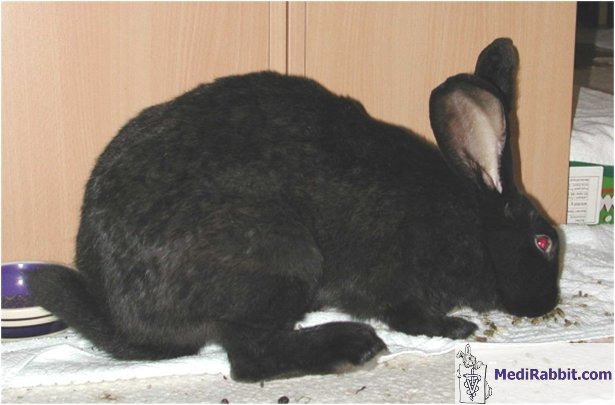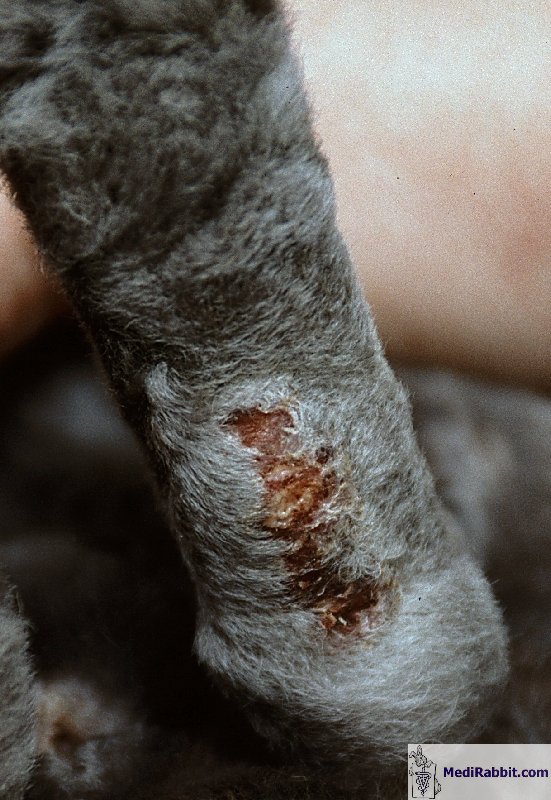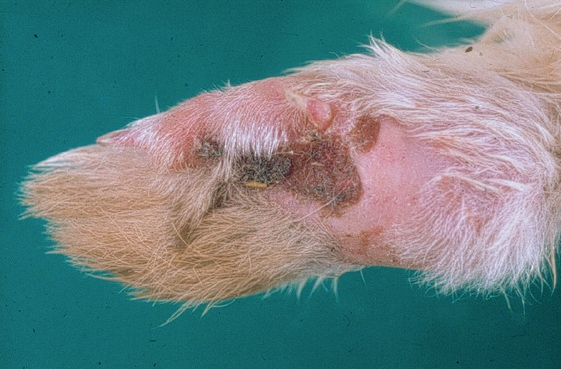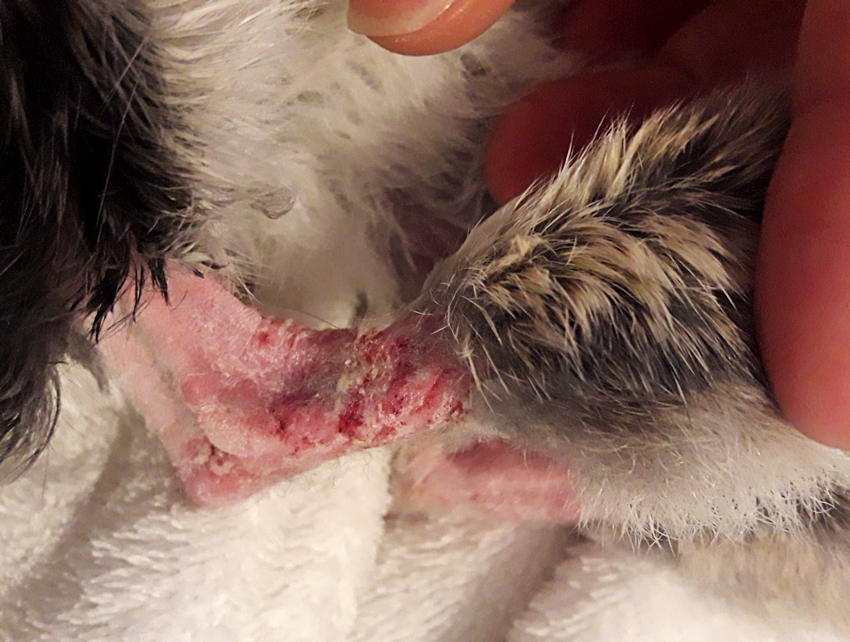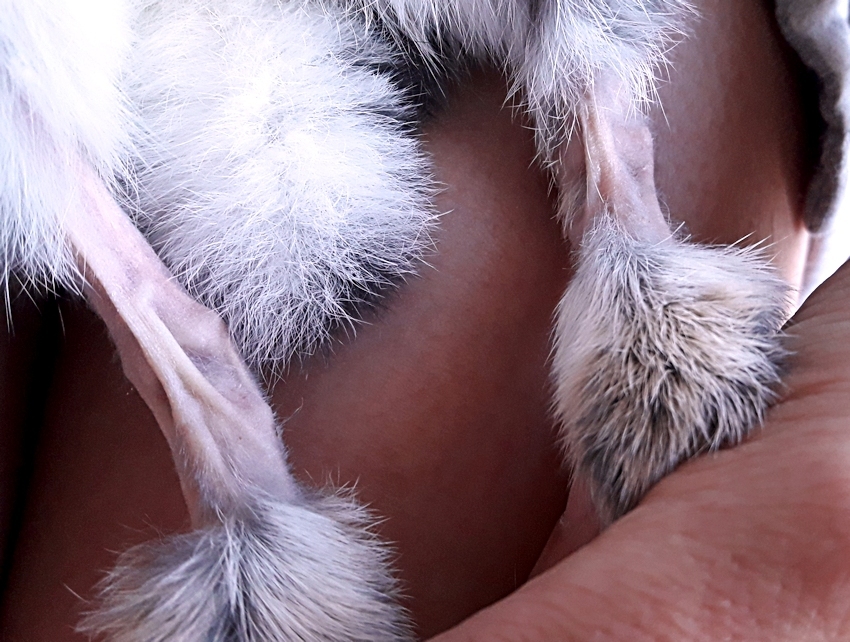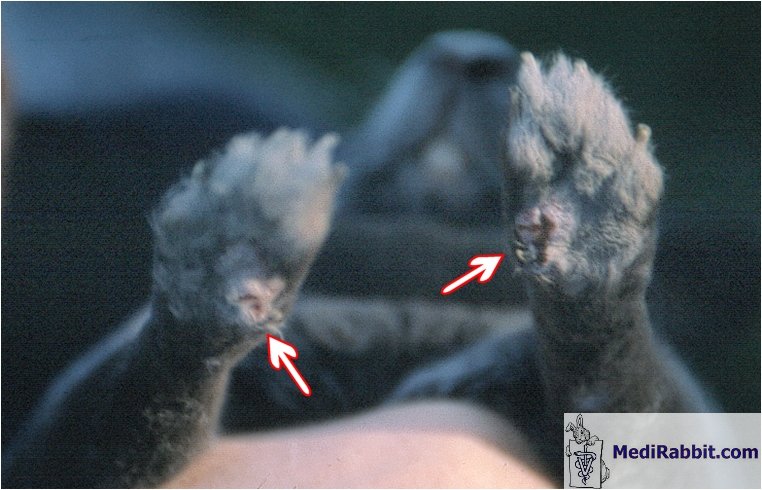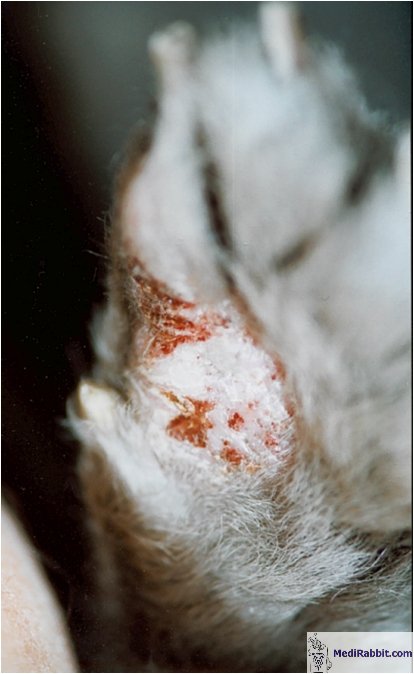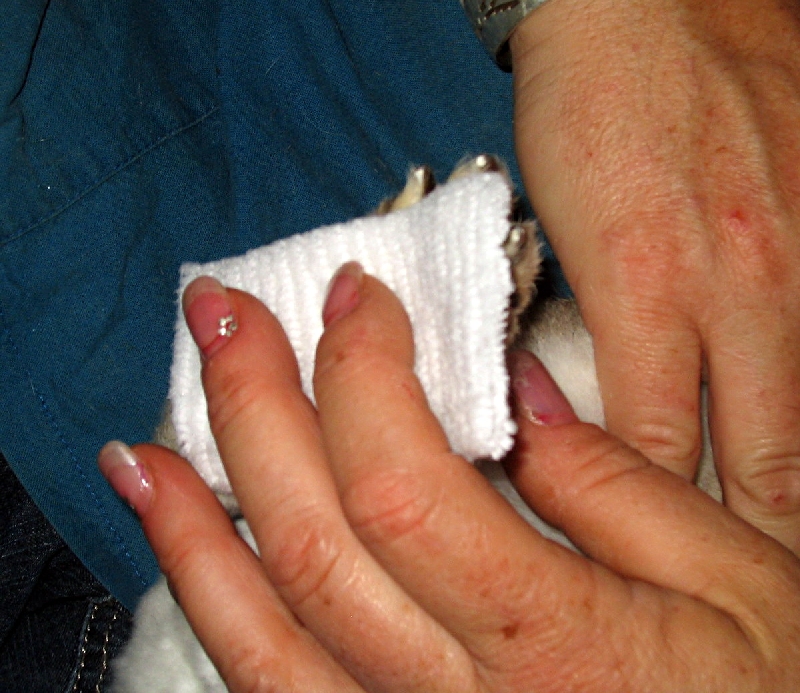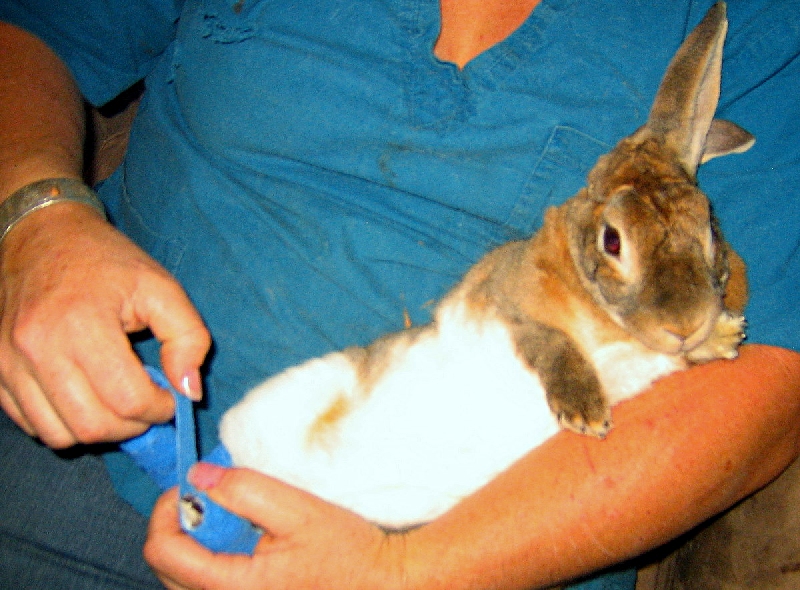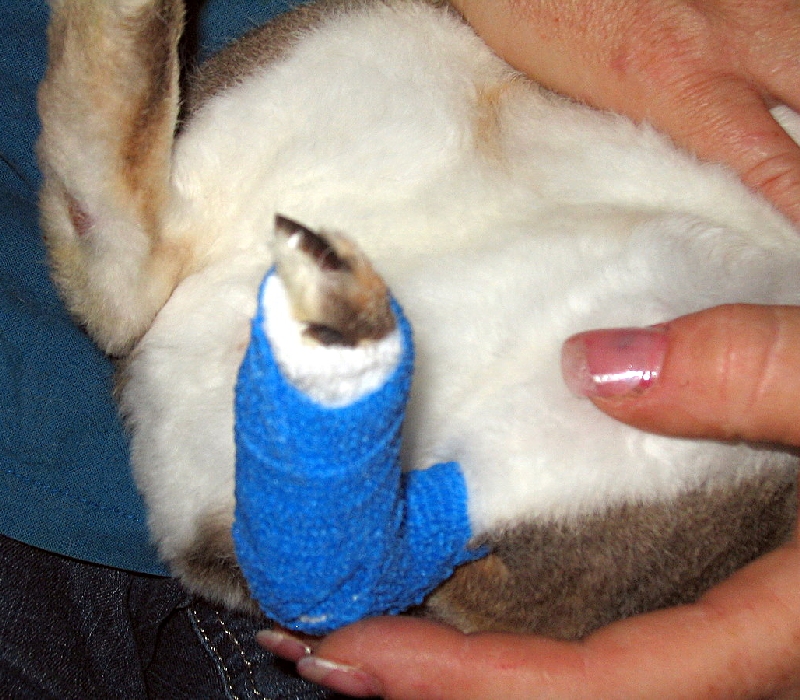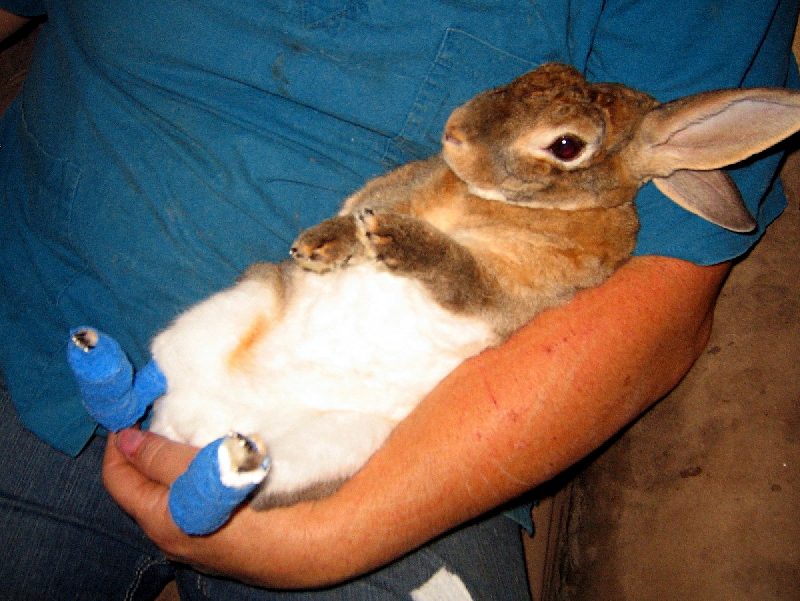Sore hocks
(pododermatitis) in rabbits
Esther van Praag Ph.D.
|
MediRabbit.com is
funded solely by the generosity of donors. Every
donation, no matter what the size, is appreciated and will aid in the continuing
research of medical care and health of rabbits. Thank you |
Warning: this
file contains pictures that may be distressing for people
Pododermatitis is a skin disease and
a musculoskeletal problem, whose origin is multifactorial. Adult rabbits are
more often affected than young rabbits, larger breeds more than smaller. The
major cause is trauma, due to the pressure on the sole caused by running on
rough and/or abrading floors (e.g. rough carpets, tiles, vinyl or wire
flooring of cages), more rarely by regular thumping of anxious or nervous
rabbits. Poor hygiene in the cage can be a further cause for pododermatitis.
Genetics play a role too. Rabbits
belonging to the Rex breed have feet padded with short soft fur that brings
little protection. In Angora rabbits, shaved for their hairy coat, hair must never
be shaved away from the bottom of their feet. Some rabbits also have a wrong
physical body position. Instead of putting weight on the toes (rabbits are
digitigrades); they place weight on the metatarsus and hock. Others position
their hind feet wrongly, by stretching them too much to the front. In both
cases, an enormous pressure is exercised on the hock, leading to pressure
sores, ulcers and abscesses.
The various causes all lead to a
decreased blood circulation in the hind limb, more rarely in the forelegs.
Lack of oxygen supply (ischemia) causes tissue necrosis. A pressure sore is
formed, which can develop into an ulcer or an abscess. The infection spreads
to deeper located tissues, which can lead to the infection of the lymphatic
nodes, the bone (osteomyelitis), or general sepsis. At this stage, the
condition is very painful, and the rabbit will avoid walking, becomes
incontinent for both urine and feces. Reduced movement reduces proper blood
circulation in the limbs. A vicious circle is thus created, and the general
condition of the rabbit decreases rapidly.
In
cases where the bone is affected, the ligaments and the tendons can be
displaced, which leads to permanent invalidity. This condition is easily
recognized by the special gait of the rabbit, with a refusal to put pressure
on its toes, and use of hocks instead.
Diagnosis
It is important to find the
cause of fur loss under the sole of rabbit feet: fur abrasion, bacterial
dermatitis, fungal dermatitis or parasitic infestation. It usually starts
with a hairless spot on the sole. The skin is thickened, inflamed and red,
with necrotic tissue in the middle of the wound. Ulcers and abscesses can be
present.
|
|||||||||||||||||
|
|
|
|
|
|
MediRabbit
Flora,
a young female Rex rabbit suffering from pododermatitis on the front feet
(left) and hind limbs (right).
|
|
Treatment
The treatment of pododermatitis needs to be on two levels:
Find the cause of pododermatitis, which includes a thorough
examination of the environment where the rabbit is living and improve it, a
reduction of weight in case of obesity, accompanied by increased exercise
possibilities.
It is recommended to clip the hair around the wound, so that it cannot
reach the wound anymore but remains long enough to protect the rest of the
foot sole. The wound needs to be disinfected, e.g. with povidone-iodine,
after which a antiseptic cream can be used. Good results were obtained with
the following antiseptic products:
- Salicylic acid 0.006%;
- Mupirocin 2%;
- Neomycin 2%;
- Manuka honey;
- HEALx cream;
- Calendula/Echinacea 5% gel
(Powervet®, Switzerland).
The use of systemic cephalosporin or azythromycin have proven
efficient in the treatment of abscesses that developed secondary to
pododermatitis. The antibiotic treatment should be done over a longer period
of time, eventually for lifetime.
If pododermatitis is accompanied by pain, analgesic should be
administered to the rabbit, e.g., meloxicam, which can be used over a longer
period without appearance of side effects in rabbits. The reduction of pain
usually encourages the rabbit to move more, which is on its turn beneficial
for the blood circulation of the wounded leg. If this is not the case, soft
massages of the limbs can help activate blood circulation in the affected
limbs.
Bandaging the feet may be helpful. This can be by mean of a liquid plaster that produces
an impermeable layer while allowing breathing of the skin. Regular bandaging
material can also be used, but must be changed regularly to avoid infection.
Rabbits are skillful bandage removers. It is therefore sometimes
useful to make a wire according to the size of the foot. This metal tube can
be filled with padding material, e.g. cork, in such a way that the wounded
area is left unperturbed and without pressure.
Ulcerative
pododermatitis is often difficult to treat and recurrence is common.
|
|
|
|
|
|
Linda Baley and Claudia Misceo
Bambi, a 5 year old female Rex rabbit suffering
from pododermatitis on the hind limbs, demonstrating bandaging of her hurt feet with soft padding and elastic
adhesive bandage.
|
|
Characterful, energy full rabbits may not
accept bandaging of a hind-foot easily. They fight and possibly try to bite
the hand or fingers handling them deeply, putting both the rabbit and the
handler/owner in danger. Especially when they are bigger-sized rabbits. A new
approach to treat pododermatitis is the use of a custom made "rabbit
sock". It has shown successful in the treatment of paw lesions and
pododermatitis in several rabbits already, reducing the size of the wounds
and leading to regrowth of the fur under the sole.
For information on these socks, please
contact: info@medirabbit.com
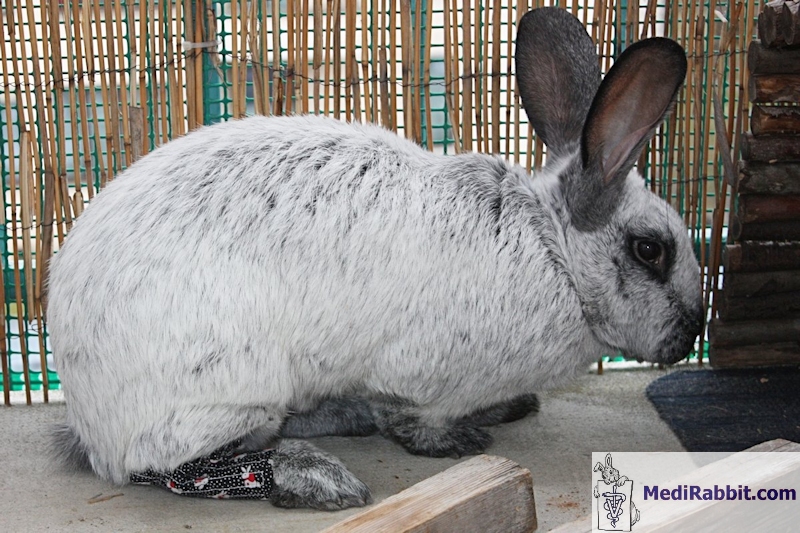

MediRabbit
Benny wearing his rabbit sock, after injuring his
hind paw. Bandaging his foot was very difficult for
him and the owner. Only after wearing his sock, the wound stopped bleeding
and started to heal.
For detailed information on pododematitis in
rabbits,
by E. van Praag, A. Maurer and T.
Saarony,
408
pages, 2010.
Acknowledgement
A special thanks to Arie van Praag
(Switzerland), Prof R. Hoop (Switzerland), Paula Carter (USA), Karine Laurençont (France), Sandy Minshull
(Canada), Linda Baley (USA), and Claudia Misceo for
the pictures of rabbits with pododermatitis.
Thank you also to Flora, Bambi and Benny
for their patience.
Further
Reading
Jong IC, Reimert H,
Rommers JM. Effect of floor type on footpad injuries in does: a pilot study.
9th World Rabbit Congress, Verona, Italy. 2008, 1171-76.
Drescher B,
Schlender-Boebbis I. Pododermatitis
(" Sore hocks") in the rabbit. Kleintierpraxis 1996:41: 99-103.
Graham JE. Rabbit wound
management. Veterinary Clinics of North America: Exotic Animal Practice
2004:7:37-55.
Harcourt-Brown F. Skin
diseases. In: Textbook of Rabbit Medicine. Oxford, UK:Butterworth-Heinemann;
2002 p 233-240.
Henfrey J. Common
dermatoses of small mammals. In Practice 1993;15:67-71.
Hermans K, Devriese LA,
Haesebrouck F. Rabbit staphylococcosis: difficult solutions for serious problems.
Vet Microbiol 2003;91:57-64.
Hoppmann E, Barron HW.
Ferret and Rabbit Dermatology. Journal of Exotic Pet Medicine,
2007:16;225-237.
Rommers JM, Meijerhof R.
1996. The effect of different floor types on footpad injuries of rabbit does.
In: Proc 6th World Rabbit Congress, Toulouse, France 1996;2:431-436.
Rosenthal
KL. How to manage the geriatric rabbit. www.floridarabbit.org Accessed:
November 2008.
e-mail: info@medirabbit.com



